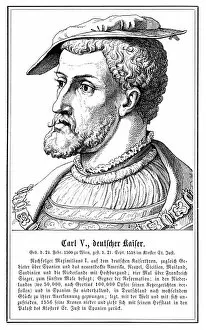Carlos V Collection (#3)
"Carlos V: A Powerful Emperor and Defender of the Faith" Carlos V, also known as Charles V, was a prominent figure in European history during the 16th century
For sale as Licensed Images
Choose your image, Select your licence and Download the media
"Carlos V: A Powerful Emperor and Defender of the Faith" Carlos V, also known as Charles V, was a prominent figure in European history during the 16th century. As Holy Roman Emperor, he faced numerous challenges and played a significant role in religious reform. One of Carlos V's most famous encounters occurred at the Diet of Worms in 1521. Here, German religious reformer Martin Luther defended himself against charges of heresy before the emperor. This historic event showcased Carlos V's commitment to upholding Catholicism and maintaining order within his empire. Beyond his political endeavors, Carlos V had a deep appreciation for art and architecture. The Alhambra from Mirador de San Nicolas in Granada, Spain stands as a testament to his love for beauty and grandeur. The palace complex within this stunning fortress reflects both Islamic and Christian influences. Throughout his reign, Carlos V maintained close ties with influential individuals such as the Fuggers—a wealthy German banking family—and Queen Mary of England. His letter to Queen Mary in 1555 demonstrates his diplomatic skills and desire for unity among European nations. The Charles V Palace within the Alhambra further exemplifies Carlos V's affinity for opulence. Its intricate design showcases his taste for luxury while serving as a symbol of power. Artistic representations like Lucas Vorsterman's portrait capture Carlos V's regal presence and authority that commanded respect throughout Europe during this era. In addition to politics and artistry, military triumphs were also part of Carlos V's legacy. Plates from Guillielmus Becanuss' works depict victories at Pavia (Italy)and campaigns in Africa—showcasing not only military prowess but also expansionist ambitions. Lastly, Jacob Cornelisz van Oostsanen’s painting "Procession of Counts" portrays important figures including Maximilian I (Carlos' grandfather) on horseback—an homage to their lineage that shaped Europe's history.


